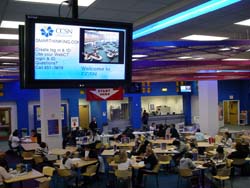- LAS VEGAS, NV-The Community College of Southern Nevada (CCSN) is one of the fastest growing community colleges in the U.S., and is the third largest single college, multi-campus community college in the country. Its service area is 42,000 square miles spread across four counties-an area about the size of the state of Virginia. In an effort to better reach its growing community of students, faculty, and staff, CCSN recently integrated video-over-IP messaging in several locations throughout the college's three main campuses, as well as some surrounding high schools in the Las Vegas metro area.
In common student areas across its three campuses, the Community College of Southern Nevada has installed approximately 60 monitors that convey topical messages via VBrick IP receivers.
CCSN president Dr. Richard Carpenter initiated the project as part of his vision of integrating more technology into the school's every-day life. The system, which went live this past August, delivers targeted messages via a Cisco application and content networking system and VBrick System's IP receivers.
"It's another communication tool in addition to e-mails, online newsletters, and hardcopies that we send out," explained Helen Clougherty, executive director of public and college relations at CCSN. "And because each monitor is capable of being individually programmed, we can program the monitors with targeted information depending on its location."
CCSN contracts its information technology services to SunGard Higher Education. CCSN's chief information officer, SunGard's Shah Ardalan, agreed. "It is an innovative way of using technology. Recruiting and communications are some of the toughest challenges in higher education. We have three main campuses and 13 remote sites-just for the fact that this system can get timely messages to all these different places is amazing. Also the fact that now our students can see messages that are targeted to them, to me that makes it extremely efficient."
One of the advantages to its system is that even though the distribution area is wide, CCSN staff can manage the operations from a single location. The content, which comes from a variety of sources, including student organizations and faculty, is gathered and developed by the division of public and college relations. It is then formatted and organized from a central location, and delivered from there to approximately 60 screens. All monitoring is also done from that space.
"We get requests all the time to put information up there," said Clougherty. "If you walk through any student areas, people are looking at what's up there; if it's being taken down for maintenance, people will point that out to us-so they are looking at these screens."
Besides simple static, rotating messages, the VBrick allows for a variety of innovative uses, and CCSN is working on ways to incorporate more video and sound. "The capability to do video and streaming video is already there," said Ardalan. "We have tested it with small pieces, we have seen demos, and we have ideas of what pieces of video to incorporate."
"The value we bring to guys like CCSN is that they can deploy one technology, one system, and with it they can provide live and stored video, but they can also hang up signs around the enterprise and display digital signage in an integrated environment without having to deploy parallel systems," said VBrick CTO Rich Mavrogeanes.
Another advantage to the system is the simplicity of expansion. CCSN is constantly growing, and is currently at work on its fourth and fifth campuses, and the site planners have monitor locations already mapped out.
Additionally, CCSN reaches out to neighboring high schools on a number of partnership programs, including installing kiosks that carry messages targeted to the students. "The response has been tremendous," said Clougherty. "It's just another way to get the message out to the students that we are here, and that we're an option for them."
"Now that we have about 60 of them out there, they're each just acting like one additional node on the network," explained Ardalan. "It's just like having another PC connected to the network, so it's going to be extremely easy to expand."
"It's our president's goal to be the most technologically advanced college in the system," concluded Clougherty. "This is just one more thing that we're doing to get there."
